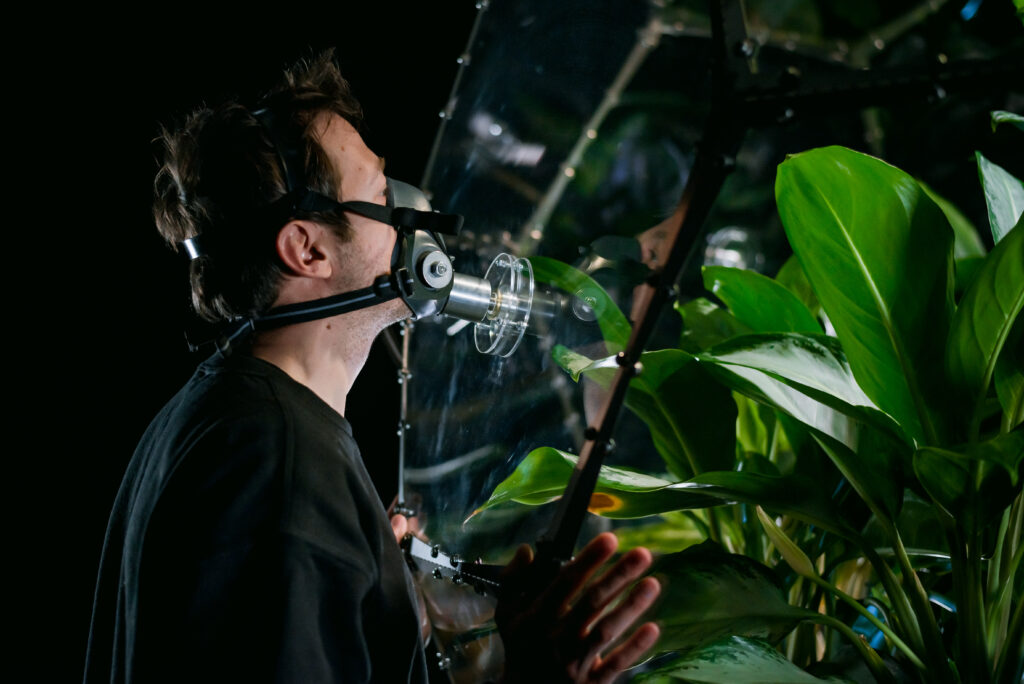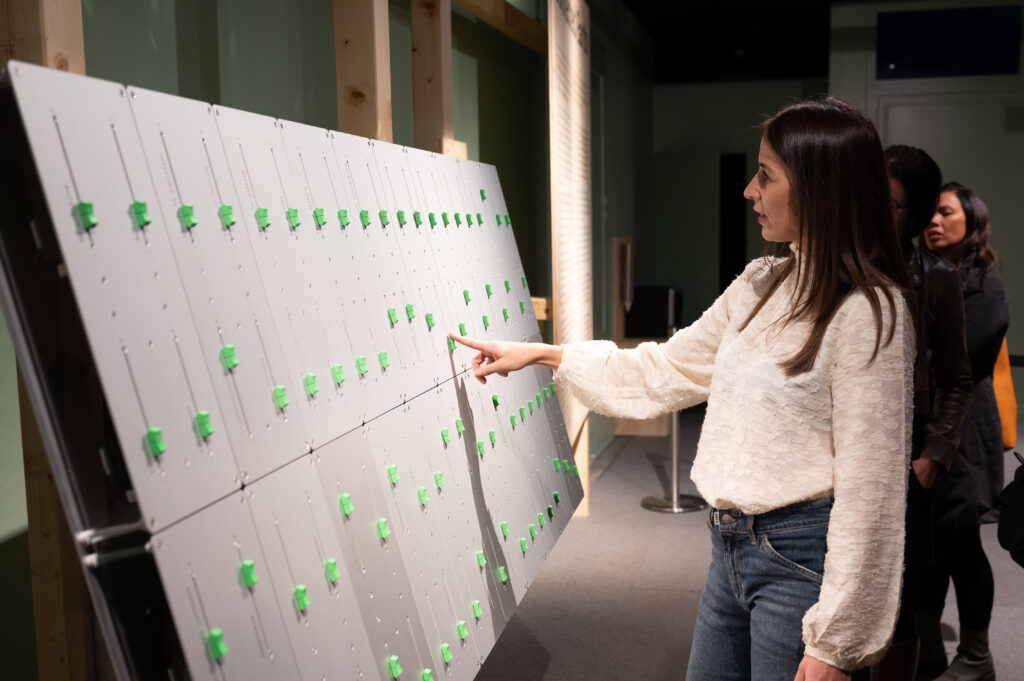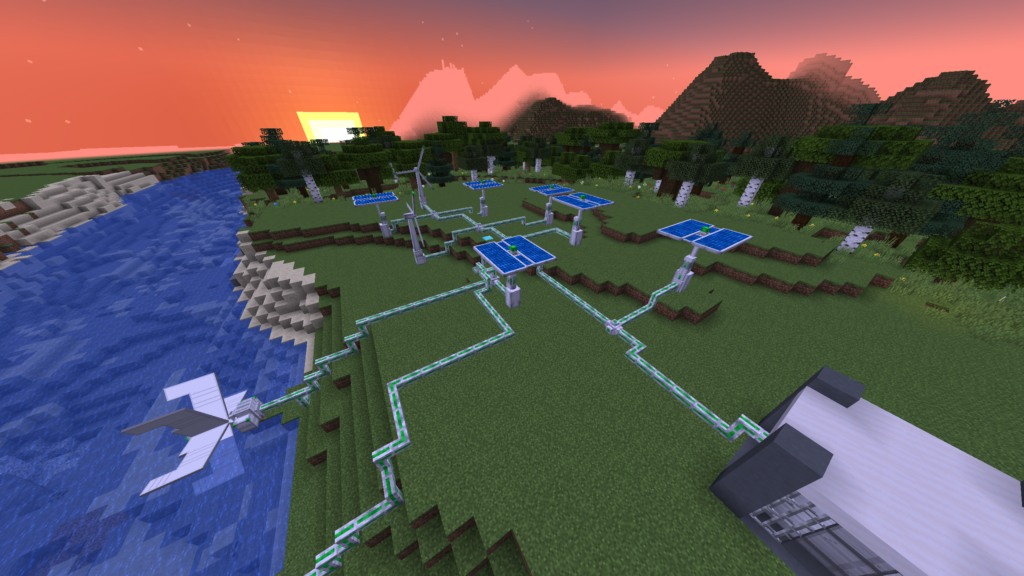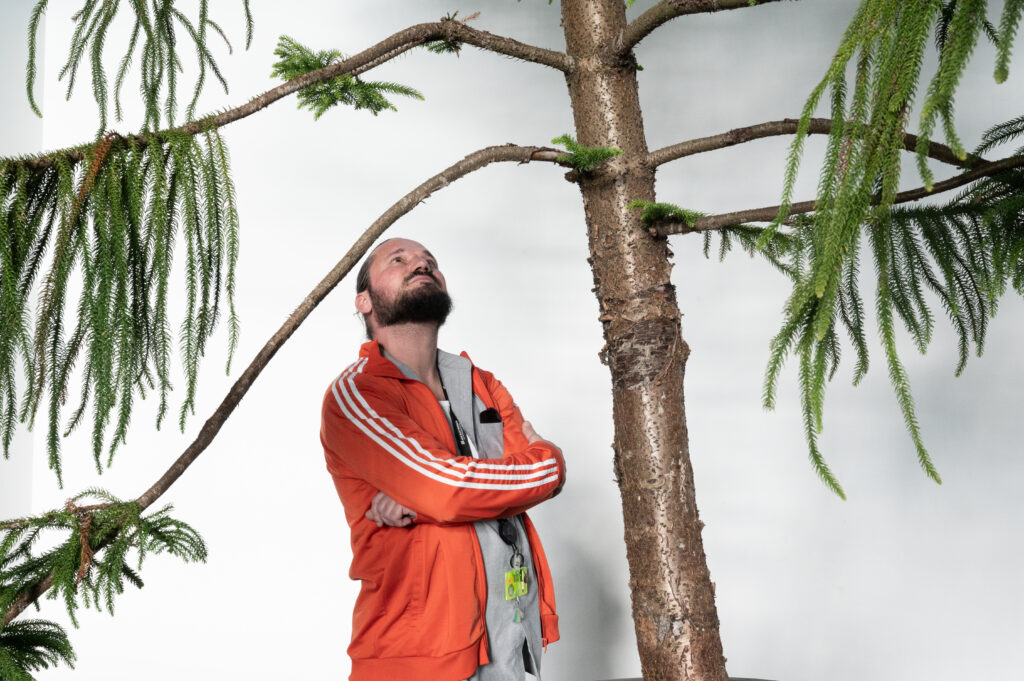- Press text as PDF
- Photos via Flickr
- Insights: Ars Electronica Blog
- More about the exhibition Connected Earth
- About the Austrian Climate and Energy Fund
(Linz, November 13, 2024) Today the Ars Electronica Center opens its new exhibition Connected Earth. In cooperation with the Austrian Climate and Energy Fund, the exhibition presents interactive artistic works and scientific stations that shed light on the interrelationships in the Earth’s ecosystem. The focus is on our shared responsibility for the planet’s fragile balance.
Everything on Connected Earth is connected. Every living creature and plant is part of a vast, largely unexplored network that permeates our planet and influences all processes. Even though no other species is changing this network as profoundly as we are, we remain inextricably linked to and dependent upon the Connected Earth. The new exhibition at the Ars Electronica Center is dedicated to our role and responsibility in the Earth’s fragile ecosystem. Art installations, data visualizations and interactive stations illuminate the complex interactions between nature, human infrastructure, climate change and energy transition.
Connected Earth, developed in partnership with the Austrian Climate and Energy Fund, follows There is No Planet B (2021-2024) and will run for two years.
Artistic Positions and New Perspectives
Selected artistic positions encourage us to take a holistic view of our environment and to adopt unusual perspectives – using our own senses, scientific measurements, technological solutions and empathy for all the actors that make up the Earth’s network.
With One Tree ID – How To Become A Tree For Another Tree, Agnes Meyer-Brandis (DE) places a five-meter-high araucaria tree in the foyer of the Ars Electronica Center and invites us to enter into a symbolic-sensory exchange with the plant world. Those interested in creating more sustainability and diversity in their own gardens can explore Pollinator Pathmaker by Alexandra Daisy Ginsberg (GB), an algorithmic tool is available at pollinator.art for designing gardens that prioritise the needs of pollinating insects.
In her installation Ex.A.R.U., Dorotea Dolinšek (SI) explores the close relationship between human life and a lush and flourishing flora. Visitors connect to a futuristic greenhouse through a breathing mask and experience first-hand the interdependence of humans and plants through the constant exchange of oxygen and carbon dioxide.
Tega Brain (AU) and Sam Lavigne (US) bring sleep, CO² emissions and capitalist structures into an entirely new dialogue, while the collective Fragmentin (CH) with G80 present the connections between socio-political and ecological issues using analogue, corresponding sliders.
Beatie Wolfe (GB) contrasts research data on the concentration of methane in the atmosphere with the misleading advertising slogans of the oil industry in her animation Smoke and Mirrors. With From Green to Red, the British artist also presents a gripping visualization of NASA’s CO² data on the façade of the Ars Electronica Center, where three other artistic works on the exhibition theme will also be shown several times.
Interactive Stations and Voices from Research
Connected Earth is intended not only to encourage reflection on our role in the complex global ecosystem, but also to show how our actions can lead to positive change. This is made clear, among other things, at the Austrian Climate and Energy Fund’s Best Practice Station, where visitors can explore Austrian flagship projects using a multi-touch terminal.
The Interactive Hydrogen Value Chains Model – by WIVA P&G, Ars Electronica, Robert Bosch AG, Linzer Technikum and LINZ AG with RAG Austria AG – demonstrates on a small scale how green hydrogen is produced and used. The Minecraft Minigame by three young developers provides a playful introduction to the topic: players from primary school age upwards are encouraged to immerse themselves in the virtual “Hydrogen World Linz”.
The KONTEXT Institute for Climate Matters (AT) and Geosocial AI (AT) are also involved in the exhibition. Both deal with the flow of information on climate change and the urgent need for action by individuals.
Topic Weekend for Families
On Saturday, November 16 and Sunday, November 17, the Ars Electronica Center will host its first Connected Earth theme weekend. Deep Space 8K will explore the question of what exactly makes the Earth such an extraordinary habitat for more than eight million species. The workshop “Lights On!” explores the phenomenon of bioluminescence in insects, fish and plankton. The workshop installation “Schmilz, Schmilz, Baby” asks how optimistic we can be about the future after the melting of the glaciers in Austria. The youngest (from four years old) go on a journey of discovery in the children’s research laboratory: together they explore how animals and plants communicate with each other, what butterflies have in common with a tornado and how hydrogen becomes a source of energy. Four special tours of Connected Earth round out the weekend program.
Das gesamte Angebot inklusive Beginnzeiten ist hier abrufbar.
The Exhibition at a Glance
Artistic Positions
One Tree ID − How To Become A Tree For Another Tree
Agnes Meyer-Brandis (DE)
One Tree ID – How To Become A Tree For Another Tree by Agnes Meyer-Brandis is a speculative biochemical and biopoetic experiment exploring olfactory communication between humans and plants. The project utilizes air molecules—volatile organic compounds (VOCs)—emitted by all plants. These compounds not only contribute to cloud formation,but are also responsible for the characteristic “forest scent” and act as a communication system between plants and insects. For the exhibition, the specific VOCs of an Araucaria tree from the Department of Urban Greenery and Street Maintenance, Linz are transformed into a perfume that visitors can apply to their bodies.
Through this act, visitors enter into a symbolic dialogue with the surrounding trees, transforming the “communication” between humans and plants into a sensory experience.
One Tree ID – Araucaria heterophylla was realized in collaboration with Prof. Dr. Manuel Selg and Klaus Krennhuber, Molecular Biology and Chemistry Department, Universityof Applied Sciences Upper Austria and Marc vom Ende, Senior Perfumer, Symrise. With the support of the City of Linz.
G80
Fragmentin (CH)
G80 is an interactive installation that proposes a contemporary interpretation of Richard Buckminster Fuller’s World Game: a War Games-inspired strategy simulation tool that aims at a “just distribution of resources” on a planetary scale. Developed in the era of cybernetics in the early 1960s, it embodies the promise that computers and mathematical models can help solve socio-political and ecological problems.
In contrast to this technocratic hypothesis, G80 questions the absurdity of the idea itself, which is rooted in a techno-capitalist system that refuses to look beyond mathematical models. The artwork shows a console with a matrix of 80 motorized sliders, reminiscent of a control room. Each slider corresponds to a variable whose name is engraved on a sign. At the ends of the sliders, the signs “+” and “-” indicate the stakes. Some variables are directly inspired by the variables developed by Buckminster, while others, new variables, shed light on the big questions of our time. Users are invited to interact with the work and playfully stabilize the world by changing the values of each variable. When they make a change, they find that all the sliders correlate with each other and the variables form changing patterns without their intervention.
Fragmentin (Laura Nieder, David Colombini, Marc Dubois)
The original edition of G80 was commissioned by Mudac (Lausanne)
With the support of Pro Helvetia
Pollinator Pathmaker
Alexandra Daisy Ginsberg (GB)
Pollinator Pathmaker is an artwork for pollinators, planted and cared for by humans. Created by the artist Alexandra Daisy Ginsberg, whose ambition is to create the world’s largest climate-positive artwork, the work is a one-of-a-kind experiment in interspecies design.
As numbers of pollinating insects around the world crash, Ginsberg worked with horticulturalists, pollinator experts, and a computer scientist to devise an algorithmic tool that designs planting for pollinators’ tastes, not human taste. The result is a growing series of algorithmically-generated living artworks, designed to maximize empathy towards pollinating insects. Every artwork generated is different, but each is computed to support the greatest diversity of pollinator species. By creating for other species, art becomes a platform for empathy and agency to care for them.
The first two Pollinator Pathmaker Editions opened in 2022; a 55m permanent installation at the Eden Project, Cornwall, and eleven meandering beds over 250m in Kensington Gardens, London, commissioned by the Serpentine. The third Edition, commissioned by LAS Art Foundation, opened in June 2023 in the forecourt of the Museum für Naturkunde, Berlin.
Winner of the 2023 S+T+ARTS Grand Prize for Artistic Exploration, Pollinator Pathmaker is not just about large public artworks: you can also use the algorithmic tool for free to make your own living artwork. Simply follow the steps at pollinator.art to select your garden conditions and play with how the algorithm solves the problem of empathy. It then generates a planting scheme for you.
In Connected Earth, two fine art pigment prints depict unrealized Pollinator Pathmaker planting schemes from the perspective of pollinating insects. The artist has digitally painted each plant that appears in her ‘Plant Palettes’, making it possible to visualize each potential living artwork in a virtual space before it is planted.
Originally commissioned by the Eden Project and funded by Garfield Weston Foundation. Founding supporters Gaia Art Foundation, Google Arts & Culture.
International Edition Founding supporter LAS Art Foundation.
This interactive exhibition version of pollinator.art was supported by Gaia Art Foundation.
Perfect Sleep
Tega Brain (AU), Sam Lavigne (US)
Sleep and dreams as climate engineering tools: Perfect Sleep by Tega Brain and Sam Lavigne examines the connection between sleep deprivation and climate change, and critiques the exploitative capitalist system that – in both cases – disregards regeneration and natural limits. The work consists of two parts: the Perfect Sleep app encourages users to experiment with their own sleep cycles and gradually increase the amount of sleep they get. Until the “perfect sleep” is achieved over 24 hours. To make falling asleep easier, visitors to the installation embark on a sensual journey through dreamscapes that are spoken and set to music. The stories are experienced from specially designed deck chairs and invite the participants to understand rest as a radical counterposition to ecological and social exploitation.
Artists: Tega Brain and Sam Lavigne
App development: Sam Lavigne
Dream incubation texts: Simone Browne, Johanna Hedva, Holly Jean Buck and Sophie Lewis
Translation: Dr. Anne Pfautsch
Dreamscape sound composition: Luisa Pereira
Dreamscape narration: Mukundwa Katuliiba (EN), Elvis Pavic (DE)
Furniture designed with Jordana Maisie Design Studio
Perfect Sleep was commissioned by the Museum Sinclair-Haus, Stiftung Kunst und Natur, Bad Homburg.
Ex.A.R.U.
Dorotea Dolinšek (SI)
The project Ex.A.R.U. (Exo Auxiliary Respiratory Unit) is an immersive installation that speculates on human survival in environments where air is scarce or unbreathable. Dorotea Dolinšek presents a futuristic greenhouse that houses tropical plants from the Aglaonema and Alocasia families — and is optimized for maximum oxygen production. Specially designed air masks are attached to the sides of the glass sculpture, which visitors can put on to become aware of the reciprocal relationship between humans and plants through the constant exchange of oxygen and carbon dioxide. The fragility and necessity of the Earth’s atmosphere are emphasized.
In addition, the artist presents a graphic work for which she breathed on paper with coal dust. Each sheet shown represents 20 minutes of her breathing and reminds us that humans connect with their environment up to 32,000 times a day through the medium of air.
Produced by: Kersnikova Institute – Kapelica Gallery within the framework of the konS ≡ Platform for Contemporary Inestigative Art | Curator: Jurij Krpan | Producers: Sandra Sajovic, Simon Gmajner | Technical solutions (development of interface, sensory system, and programming): ::vtol:: (Dmitry Morozov) | Technical support: Jure Sajovic, Valter Udovičić, Jan Lavrič, Vuk Emiliano Valecic , Albin Bobnar | Textile design: Uroš Topić | Acknowledgement: Barbara Sušnik | Sketch and construction set-up: Rompom d.o.o.
Research and development were implemented within the framework of the konS ≡ Platform for Contemporary Investigative Art and co-funded by the Republic of Slovenia and the European Regional Development Fund of the European Union.
Smoke and Mirrors
Beatie Wolfe (GB)
Smoke and Mirrors powerfully contrasts the oil industry’s marketing campaigns with the alarming increase in methane concentrations in the atmosphere. The four-and-a-half-minute animation visualizes the rapid increase in methane since 1970, while highlighting misleading slogans such as “Out to clean the air” from Amoco and “Net-Zero” from Shell, which the fossil fuel industry uses to deny environmental damage and cast doubt on the science and its measurements worldwide. The articles and commercials for the slogans are available in full in the exhibition.
Beatie Wolfe’s visualization is based on the iconic “Blue Marble” photo of the Apollo 17 crew from 1972. The climate data comes from the Oceanic and Atmospheric Administration NOAA and the European Environment Agency. The animated globe is accompanied by “Oh My Heart” – the first record made from sustainable bioplastics, which Beatie Wolfe produced together with Michael Stipe and Brian Eno’s “EarthPercent”.
Visualization produced in collaboration with Parliament
From Green to Red
Beatie Wolfe (GB)
From Green to Red visualizes historical NASA data on atmospheric CO2 concentrations over the past 800,000 years. It reveals the extent of human (mis)behavior on planet Earth. The visualization will be projected onto the facade of the Ars Electronica Center daily between 9 p.m. and midnight.
Climate Countdown
Liang Jimenez, Alexa VanSuch, Reed Reed
Inspired by our rapidly changing climate, Climate Countdown takes viewers on a dynamic audiovisual journey through weather events. The display on the façade of the Ars Electronica Center takes viewers through an accelerated process of climate change – and the resulting climatic extremes. The climate clock shows how much time remains until the effects of climate change are irreversible. Climate Countdown thus reinforces the message of the well-known Climate Clock project by activists Gan Golan, Andrew Boyd, artist Katie Payton Hofstadter and Adrian Carpenter.
Connected Centre
Peter Holzkorn / Ars Electronica Futurelab (AT)
Every living thing communicates its connection to the world. The Ars Electronica Center, with its changeable façade, will be reinterpreted under the theme of “Connected Earth” because its recorded surfaces have a direct effect on its viewers. Live sensor readings of air quality, water levels and weather conditions are transformed into a visual narrative language that bathes the Ars Electronica Center in vibrant color and transforms the data into an emotional experience.
Data: Air Quality Index: World Air Quality Index project / Umweltbundesamt
Danube Water Level: Oberösterreichische Landesregierung, Abteilung Wasserwirtschaft
Weather Data: Geosphere Austria
Play the Façade: Landmarks for Future
Jakob Glasner (AT)
SOS Landmarks for Future confronts us humans with the question of who will come to the aid of the ecosystem and thus our own future. The abbreviation SOS leaves room for interpretation: Save Our Souls? Save Our Species? Swap Our System? – What do we want to preserve or change? On November 16 and 17, 2024, visitors will be able to try out the application: using a smartphone, they can project the SOS signal together with their own message via the 40,000 LEDs on the façade into the Linz night sky.
Interactive Knowledge Stations
Best Practice
Klima- und Energiefonds Österreich
At the Best Practice Station, visitors can use a multi-touch terminal to discover the flagship projects of the Climate and Energy Fund and its network of partner companies. The interactive interface showcases innovative projects on energy and mobility transformation as well as well thought-out adaptation strategies to climate change. A map of Austria with images and videos makes it easy to find out which projects are already being implemented in your own region.
The success stories are meant to inspire: a climate-neutral Austria is possible – thanks to home-grown innovations and committed people in cities, communities and regions who are working for a future worth living.
Climate Matters
KONTEXT Institute for Climate Matters (AT)
Although climate change has become a major topic of discussion in many areas of life, there is still a gap between critical awareness and meaningful progress. Despite existing proposals for solutions, there is a lack of consistent action. The KONTEXT Institute for Climate Issues is addressing this inaction by conducting detailed analyses of climate policy developments and investigating the key political, economic and social factors behind the delay in climate protection.
As part of the Connected Earth exhibition, ‘climate questions’ are integrated into the space, reminding us of our own responsibility for effective solutions and necessary action. A QR code can be used to access relevant climate data and facts via a smartphone.
This Station for Further Information was developed with the generous support and expertise of the KONTEXT Institute for Climate Matters.
Interactive Hydrogen Value Chains Model
WIVA P&G, Ars Electronica, Robert Bosch AG, the Linzer Technikum, LINZ AG with RAG Austria AG have jointly developed an interactive hydrogen value chain model: Visitors are asked to generate energy through movement to power a real PEM electrolysis process for splitting water into oxygen and hydrogen. Shortly afterwards, the energy stored in the form of hydrogen is converted back into electrical energy to power a small globe. In this way, the model illustrates the production, storage and use of green hydrogen and explains its role in future energy systems.
For a more detailed explanation of the hydrogen model, visit the ‘Hydrogen as a source of energy’ interactive information station.
This project was funded by the City of Linz Climate Fund.
Project partners: WIVA P&G, Ars Electronica, Robert Bosch AG, Linzer Technikum and Linz AG
With the kind support of RAG Austria AG
Minecraft Minigame
Simon Ehrenhuber (AT), Roberto Husli (AT), Matthias Steininger (AT)
Minecraft is one of the most played online games in the world and fascinates children, teenagers and adults alike with its virtual worlds. Three students at the Linz Technikum have capitalized on the game’s popularity by creating their own add-on, in which hydrogen production becomes an adventure in three exciting levels. The game takes place in a virtually reconstructed Linz.
In the first level, players must generate the green energy needed to produce hydrogen – wind and solar power are options. Once this has been achieved, the second level requires players to build an electrolyzer that splits water into hydrogen and oxygen. Finally, in Level 3, hydrogen is produced and its importance as a green energy source is demonstrated. When the miniature version of the steel mill emits smoke, the excavator moves, and an underground tank fills, all tasks are completed. The game can now be played at the Ars Electronica Center.
This project was financed by the City of Linz’s climate fund.
Conspiracies in Virtual and Geographic Space
Geosocial AI (AT)
The Geosocial AI Research Group’s DEGENET project explores the social relevance of the spread of fake news, hate speech, and conspiracy theories online, and investigates how the harmful dynamics operate across geosocial media platforms. The title stands for “Threats to democracy on the net”. DEGENET examines virtual networks in social media for their spatial-geographic patterns to determine where hotspots and communities of conspiracy theories can be found. The project aims to educate policymakers and the public about the need for potential regulation and to adapt strategies for education and civil society to address these issues.
Bernd Resch, Nefta Kanilmaz, Christina Zorenböhmer, Thomas Steinmaurer




